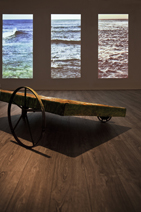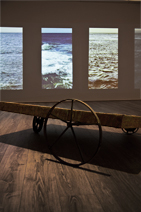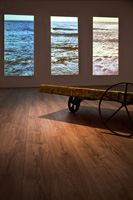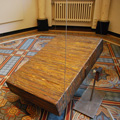MARGARETA HESSE |
works | biographie | exhibitions | catalogues | news | contact |
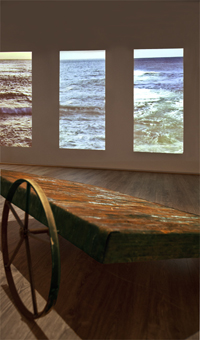 Floods of Light, 2007 four -part video projection, 30 minutes Vehikel, 2008 kinetic object, brass plated, corroded band steel, iron wheels, programmed motor 45 x120 x150 cm |
Likewise a recent four-part video projection
by Margareta Hesse is based on spaces created or flooded by light
that atmospherically embrace visitors. In the best tradition of
Claude Monet’s earlier series of paintings, the photographic-filmic
work Lichtfluten (2007), made however in the wake of the artificial
light of the laser, also focuses on the natural light of the changing
times of day. It shows four identical views of the sea’s breaking
waves as well as the horizon at four totally different times of
day, from a stationary camera perspective, in 30-minute loops that
are projected adjacently on an exhibition wall. Margareta Hesse
herself comments on the observation of light in these highly meditative
loops of sea views: ‘I filmed the changing colours of the
light reflections on the water, or more precisely the sea, over
the course of a day – from blue grey darkness via grey dawn
to the glistening bright high-contrast intensity of daylight, from
the warm tones of afternoon light until the return of black darkness
from a fixed camera position and projected them adjacently in four
out-of-synch sequences.’
|
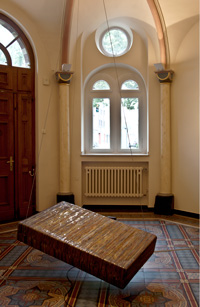
Pendulum, 2013 kinetic object, brass plated, corroded band steel, steel cable, programmed electromagnet 100 x150 x 20cm |
A similarly mysterious Kafkaesque object with a
moving pendulum dominates the so-called Kapellchen space at Ahlener
Kunstmuseum (a kinetic object with an electromagnet, brass-plated
and with corroded band steel and steel cable, 100 x 150 x 20 cm).
Randomly programmed, an electromagnet begins to draw the pendulum
out of its stationary position and closer and closer to it, until
both make contact with a loud bang, staying connected for some moments
during which there is an accompanying magnetic-electric buzzing
sound. The sensory-virtual moments in the works of art by Margareta
Hesse are here combined with kinetic components to create an all-encompassing
impression of vigorous animation, in which the viewer is able to
simultaneously recognize a metaphorical meaning.
|
© 2020 MARGARETA HESSE - all rights reserved |
